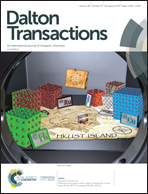Mixed precious-group metal–organic frameworks: a case study of the HKUST-1 analogue [RuxRh3−x(BTC)2]†
Abstract
This work presents the first full series of mixed precious-group metal–organic frameworks (MPG-MOFs) using ruthenium and rhodium. The obtained crystalline, highly porous and thermally robust materials were characterized by means of powder X-ray diffraction, N2/CO2 sorption isotherms, thermogravimetry, spectroscopy methods (IR, Raman, UV/VIS-, NMR and XPS) and as well by high resolution transmission electron microscopy (HR-TEM) with elemental mapping (HAADF-EDS). Additionally, the assignment of spectroscopic data is supported by computational (time dependent)-density functional theory methods. The materials turned out to consist of homogeneously dispersed Ru2 and Rh2 paddlewheel units being linked by benzenetricarboxylate (BTC) to yield a framework that is isoreticular to [Cu3(BTC)2] (HKUST-1, Hong Kong University of Science and Technology). However, acetate (OAc) is incorporated as an intrinsic component which compensates for missing BTC-linker defects and some Cl is coordinated to the Ru centre at an apical position. The exact empirical formula of the MPG-MOFs is derived as [RuxRh3−x(BTC)2−a(OAc)b(Cl)c].
![Graphical abstract: Mixed precious-group metal–organic frameworks: a case study of the HKUST-1 analogue [RuxRh3−x(BTC)2]](/en/Image/Get?imageInfo.ImageType=GA&imageInfo.ImageIdentifier.ManuscriptID=C9DT01198F&imageInfo.ImageIdentifier.Year=2019)


 Please wait while we load your content...
Please wait while we load your content...